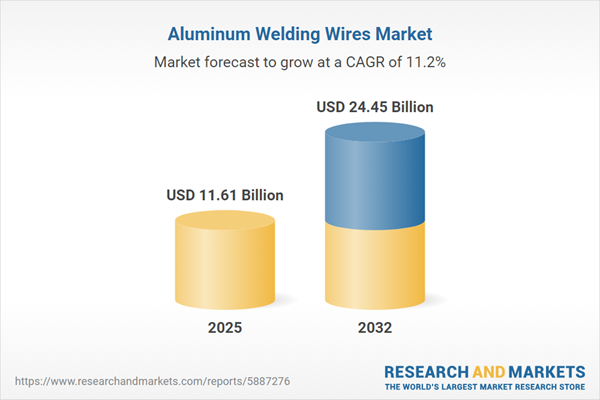Speak directly to the analyst to clarify any post sales queries you may have.
Senior decision-makers in manufacturing increasingly look to the aluminum welding wires market to optimize operations, support compliance, and adjust sourcing strategies amid evolving technologies and regulations.
Market Snapshot: Aluminum Welding Wires Market Trends and Outlook
As of 2024, the aluminum welding wires market stands at USD 10.46 billion, with projections reaching USD 11.61 billion in 2025, representing a compound annual growth rate of 11.19% through 2032. This expansion is driven by greater automation across key manufacturing applications, with a focus on efficiency and consistent quality. Sectors such as automotive, aerospace, marine, and consumer goods are investing in aluminum welding wires to enable lightweight product design and meet sustainability goals. Ongoing shifts in regulatory frameworks and supply chain models require procurement leaders to reassess strategies to support both compliance and business continuity.
Scope & Segmentation of the Aluminum Welding Wires Market
The aluminum welding wires market segmentation provides valuable insights for aligning operational planning with compliance and industry development. Segment analysis uncovers opportunities for manufacturers to leverage technological shifts and anticipate industry demands.
- Product Form: Offers both flux cored and solid wires to fit various production needs, including high-volume manufacturing and projects where weld accuracy is critical.
- Welding Process: Encompasses methods such as gas tungsten arc welding (AC/DC), laser beam welding for specialized tasks, and metal inert gas welding, supporting automated and scalable operations.
- End Use Industry: Serves the unique standards of automotive, aerospace, marine, oil and gas, construction, and consumer goods sectors, each placing high value on reliability and compliance.
- Alloy Type: Provides manufacturing flexibility with aluminum-copper, magnesium, manganese, silicon, and zinc alloy options tailored to mechanical property requirements.
- Diameter Range: Supports a varied assembly landscape, from wires under 0.8 mm for precise work to diameters over 1.6 mm for robust structural applications.
- Geographic Coverage: Covers the Americas, Europe, Middle East and Africa, and Asia-Pacific, enabling visibility into differences in regional standards and supplier practices.
- Leading Companies: Lincoln Electric Holdings, ESAB Corporation, voestalpine AG, Illinois Tool Works Inc., Air Liquide S.A., Panasonic Corporation, JFE Holdings, Kobe Steel, Shandong Hongniu Welding Materials, and Jasic Technology Co., Ltd. offer deep expertise and global reach.
Key Takeaways for Senior Decision-Makers
- Aluminum welding wires enable agile production, supporting lightweight and high-performance product requirements in multiple industries.
- Continuous improvements in alloy designs and integration with automated systems help manufacturers reduce manual labor while improving weld consistency.
- Building strong supplier ecosystems fosters operational stability and allows organizations to manage shifting supply and demand conditions more effectively.
- Embracing digitalization and robotics elevates traceability, tightens quality control, and enhances ongoing operational performance.
- Collaboration with technical experts and trusted suppliers supports broader market access and compliance, especially in highly regulated fields.
Tariff Impact: Adjusting to Changing Trade and Sourcing Conditions
Shifts in U.S. tariff policy reinforce the need for bolstering domestic supply chains and expanding regional partnerships. Maintaining a diversified supplier network remains a cornerstone for minimizing risks and supporting uninterrupted production.
Methodology & Data Sources
This analysis was developed using a mixed-method approach, combining insights from R&D, production, and procurement professionals. All findings were validated through in-depth reviews of global welding standards and regulatory trends, with peer input ensuring practical recommendations for executive action.
Why This Report Matters
- Enables organizations to proactively adjust procurement strategies, align with evolving compliance rules, and minimize risks within the supply chain.
- Empowers leaders to evaluate and implement new production technologies, secure reliable partners, and advance sustainability and reliability objectives.
- Serves as a practical guide for connecting procurement with shifting market conditions, providing direction for operational improvement and competitive positioning.
Conclusion
Using focused intelligence across sourcing, technology, and compliance, senior leaders are equipped to anticipate changes, reinforce their market stance, and achieve sustainable operational improvements.
Additional Product Information:
- Purchase of this report includes 1 year online access with quarterly updates.
- This report can be updated on request. Please contact our Customer Experience team using the Ask a Question widget on our website.
Table of Contents
3. Executive Summary
4. Market Overview
7. Cumulative Impact of Artificial Intelligence 2025
Companies Mentioned
The companies profiled in this Aluminum Welding Wires market report include:- Lincoln Electric Holdings, Inc.
- ESAB Corporation
- voestalpine AG
- Illinois Tool Works Inc.
- Air Liquide S.A.
- Panasonic Corporation
- JFE Holdings, Inc.
- Kobe Steel, Ltd.
- Shandong Hongniu Welding Materials Co., Ltd.
- Jasic Technology Co., Ltd.
Table Information
| Report Attribute | Details |
|---|---|
| No. of Pages | 181 |
| Published | October 2025 |
| Forecast Period | 2025 - 2032 |
| Estimated Market Value ( USD | $ 11.61 Billion |
| Forecasted Market Value ( USD | $ 24.45 Billion |
| Compound Annual Growth Rate | 11.1% |
| Regions Covered | Global |
| No. of Companies Mentioned | 11 |









